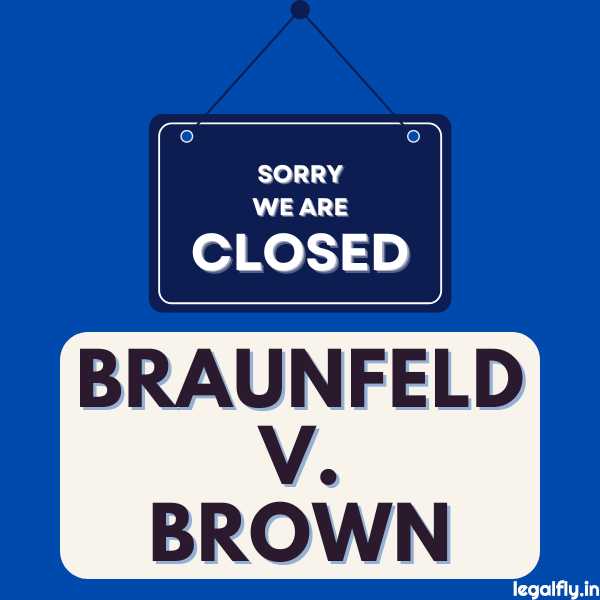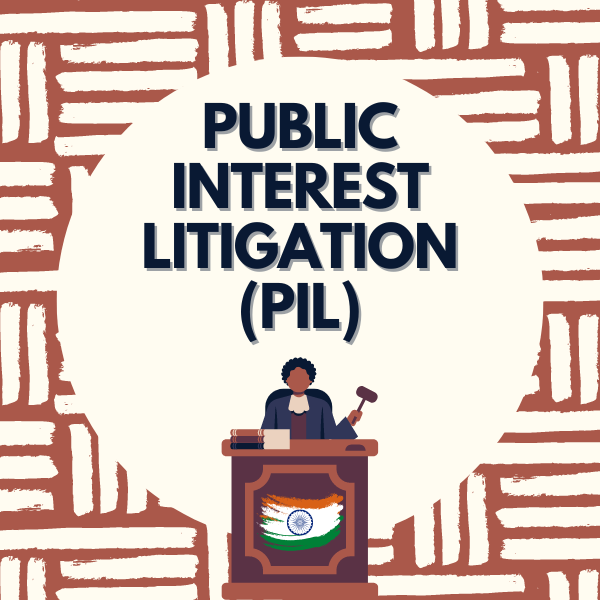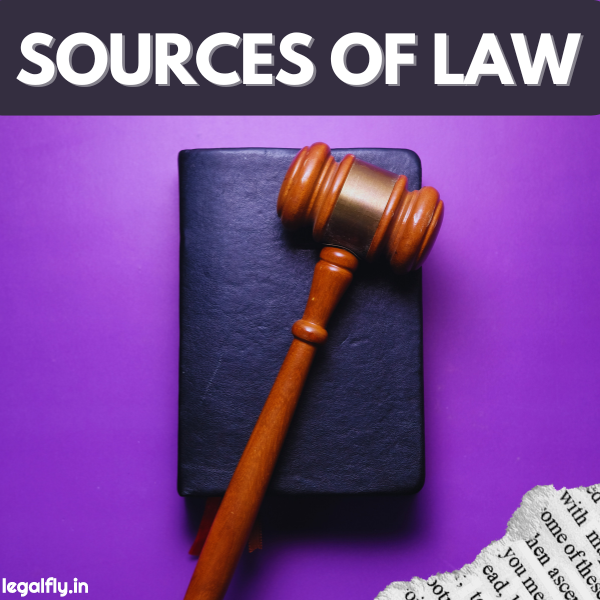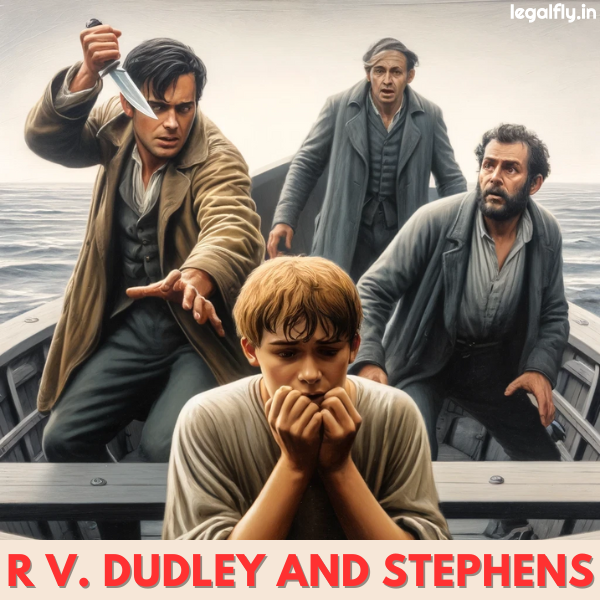Case Name: Braunfeld v. Brown
Court: Supreme Court of the United States
Year: 1961
Citation: 366 U.S. 599 (1961)
Table of Contents
Introduction to Braunfeld v. Brown
Braunfeld v. Brown was a landmark 1961 Supreme Court case that examined the boundaries between religious liberty and state laws. The case centered around Orthodox Jewish merchants in Philadelphia who were negatively impacted by a Pennsylvania blue law requiring retail businesses to close on Sundays. The merchants, led by Abraham Braunfeld, claimed that closing their businesses on Sundays placed them at an economic disadvantage compared to non-Sabbatarian competitors. They argued that the law violated their First Amendment right to exercise their religion freely.
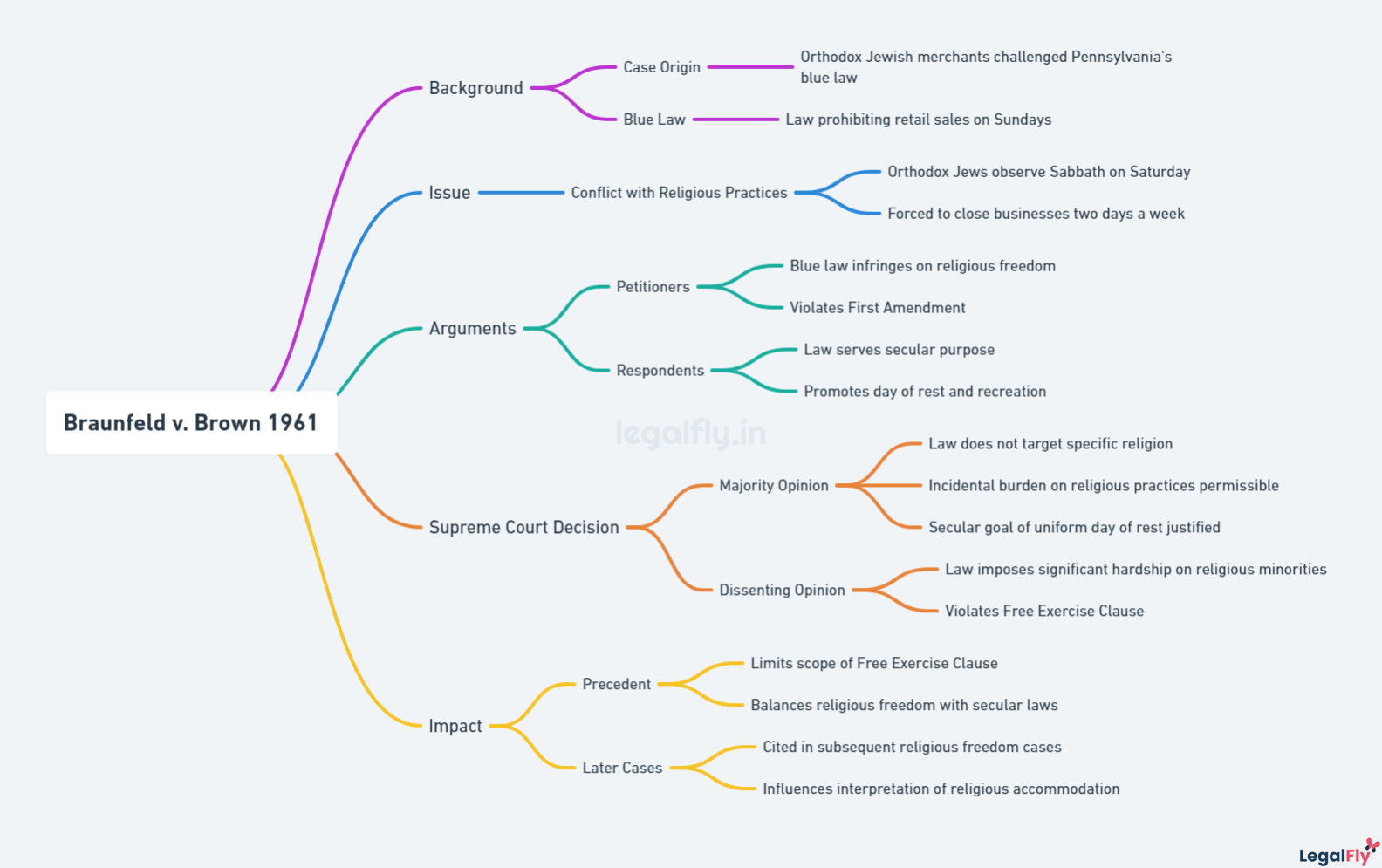
The case involved a conflict between Pennsylvania’s blue laws, which mandated Sunday closings for commercial activities, and Orthodox Jewish business owners who observed a Saturday Sabbath. The lead plaintiff, Abraham Braunfeld, owned a clothing store and adhered to Orthodox Jewish practices, including closing his business on Saturdays. Braunfeld argued that the blue law requiring Sunday closings imposed an economic hardship and disadvantage compared to non-Sabbatarian competitors. The legal questions centered around whether the state could restrict commercial activities on Sundays despite the economic burden this placed on religious minorities.
The Core Legal Issue
The core legal issue in Braunfeld v. Brown was the conflict between Pennsylvania’s Sunday closing laws, also known as “blue laws,” and Orthodox Jewish business owners whose religious practices required them to close their businesses on Saturdays. The plaintiffs, Orthodox Jewish merchants, argued that the laws infringed on their First Amendment right to freely exercise their religion by forcing them to choose between following their faith and losing business or keeping their shops open on Saturday in violation of their beliefs.
The state of Pennsylvania contended that the laws did not target any particular religion and served the secular purpose of providing a uniform day of rest for all citizens. They asserted that the burden on religious practice was indirect and did not violate the First Amendment. The plaintiffs responded that the burden was substantial and, in effect, penalized them for practising their religion. This conflict between religious freedom and Sunday closing laws formed the core legal dispute in the case.
The Supreme Court’s Analysis
Majority Opinion and Its Reasoning
The majority opinion in Braunfeld v. Brown was delivered by Chief Justice Earl Warren, joined by Justices Black, Clark, Whittaker and Stewart. The majority ruled against Braunfeld, upholding the constitutionality of Pennsylvania’s Sunday closing laws.
Warren argued that the Sunday closing law did not prohibit religious practices per se but only made religious observance more expensive by forcing some to choose between resting on Sunday or another day. The law was intended to establish a uniform day of rest, not to oppress religion. As it did not make religious practices themselves unlawful, the majority found no First Amendment violation.
Dissenting Opinions and Their Perspectives
Justice Brennan issued a dissenting opinion, joined by Justice Frankfurter. Brennan argued that the Sunday law clearly burdened Braunfeld’s religious freedom and should be struck down. Though indirect, the financial burden was substantial and inhibited Sabbatarian religious practices.
Justice Stewart also dissented separately. He stated that the Sunday law was clearly designed to disadvantage Sabbatarians, making their religious observance more costly. In Stewart’s view, this constituted an unconstitutional infringement of religious freedom.
Implications of the Decision
The Supreme Court’s ruling in Braunfeld v. Brown had significant implications for religious practice laws in the United States. The majority opinion upheld the constitutionality of “blue laws” that required businesses to close on Sundays, even when they burdened religious minorities like Orthodox Jews who observed a different Sabbath.
This precedent meant states could enact laws that inadvertently disadvantaged religious groups as long as the laws did not directly or intentionally target specific religions. The ruling affirmed the government’s ability to pass generally applicable laws that may infringe on religious exercise. It established that there is no absolute right to religious exemptions from neutral laws.
Braunfeld v. Brown also influenced subsequent First Amendment cases involving religious freedom. Building on this decision, the Court ruled in Sherbert v. Verner (1963) that states must meet strict scrutiny if their laws substantially burden religious practice. This required the government to prove a compelling interest and that the law was the least restrictive means of achieving its goals. Sherbert thus provided more protections than Braunfeld’s rational basis approach.
However, Employment Division v. Smith (1990) largely reversed Sherbert and returned to Braunfeld’s principles by finding that neutral, generally applicable laws can be upheld even if they burden religion. This precedent is still controversial today, as many argue it improperly restricts Free Exercise rights compared to the higher scrutiny of Sherbert. Braunfeld played a crucial role in shaping this complex area of First Amendment jurisprudence.
Case Significance and Legacy
Braunfeld v. Brown established important legal precedents regarding the balance between religious freedom and state laws. The Supreme Court ruled that the Pennsylvania blue law did not violate the First Amendment’s free exercise clause, even though it placed an economic burden on business owners like the Braunfelds who observed a Saturday Sabbath.
This precedent meant that religious objectors had no absolute right to be exempt from general laws that unintentionally infringed on religious practices. As long as the law did not directly or primarily target religion, it could be upheld even if it imposed an incidental burden.
The case has had a lasting influence on religious liberty jurisprudence. Justice Brennan’s concurrence introduced the idea of analyzing free exercise claims under strict scrutiny if a law substantially burdened religion. The court adopted this view in Sherbert v. Verner (1963) and Wisconsin v. Yoder (1972) but later scaled back it in Employment Division v. Smith (1990).
Braunfeld’s legacy remains relevant in contemporary debates about religious exemptions from general laws, like in the Hobby Lobby (2014) and Masterpiece Cakeshop (2018) cases. It represents a pivotal moment in balancing religious freedom against state interests in a pluralistic society. The principles established in Braunfeld continue to shape the legal analysis of First Amendment religious liberty claims.
Comparative Analysis
Braunfeld v. Brown was not the first case to address conflicts between religious practices and government laws. Earlier cases, like Reynolds v. United States (1879), dealt with religious freedom challenges to laws banning polygamy. In Reynolds v. United States, the Supreme Court ruled against the Mormon plaintiff, establishing limits on religious liberty when practices violate social norms and criminal laws.
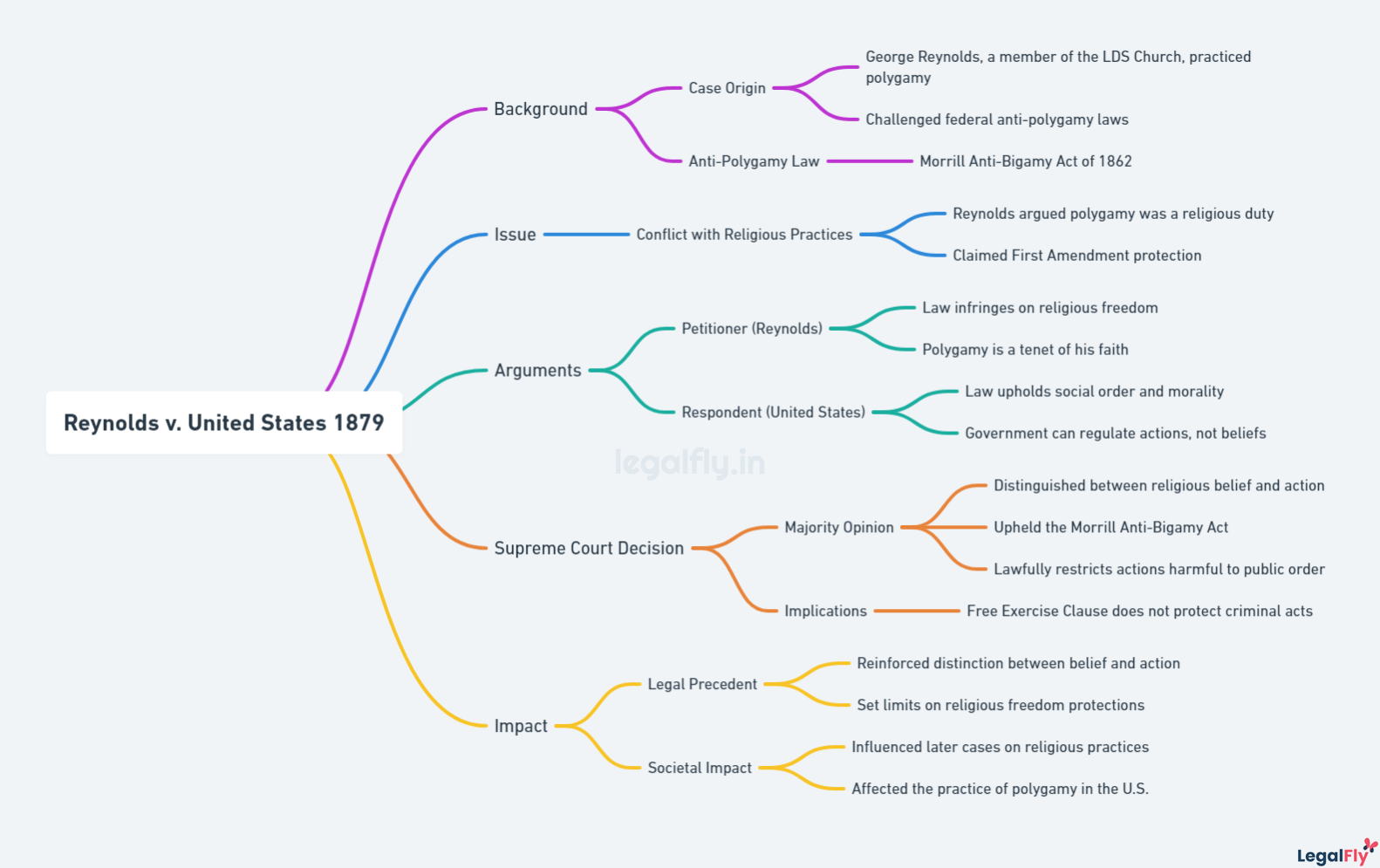
After Braunfeld, the Court heard several other significant religious freedom cases that built upon its precedents. In Sherbert v. Verner (1963), the Court ruled in favour of a Seventh-Day Adventist denied unemployment benefits due to her refusal to work on Saturdays. This established the “Sherbert test” for analyzing religious freedom claims. The Court applied a strict scrutiny standard, requiring the government to demonstrate a compelling interest when burdening religious exercise.
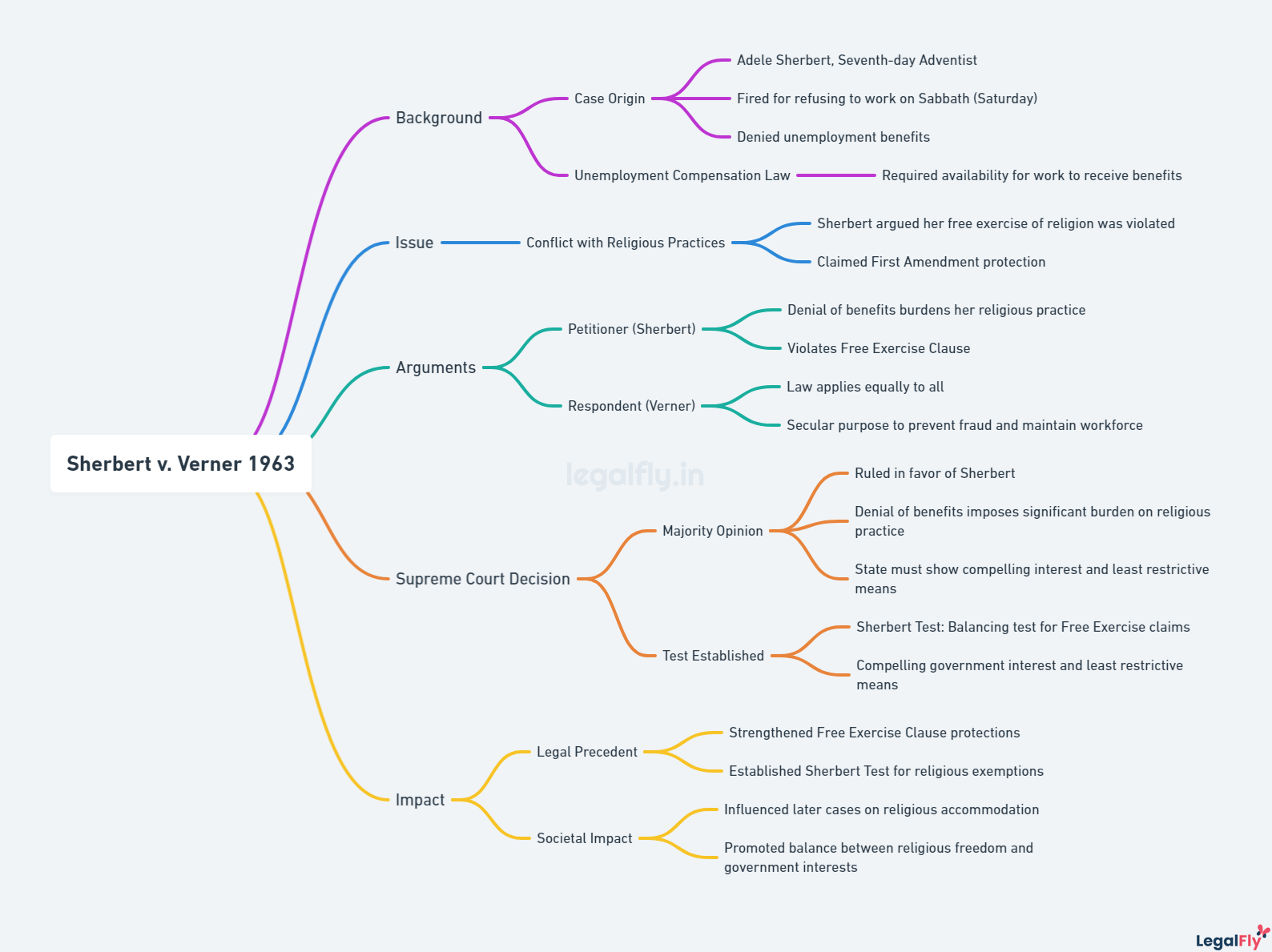
However, in Employment Division v. Smith (1990), the Court moved away from Sherbert by ruling that neutral, generally applicable laws do not violate the Free Exercise Clause even if they incidentally burden religion. Congress responded by passing the Religious Freedom Restoration Act (RFRA) in 1993 to restore the Sherbert compelling interest test. Many states also enacted their own RFRAs.
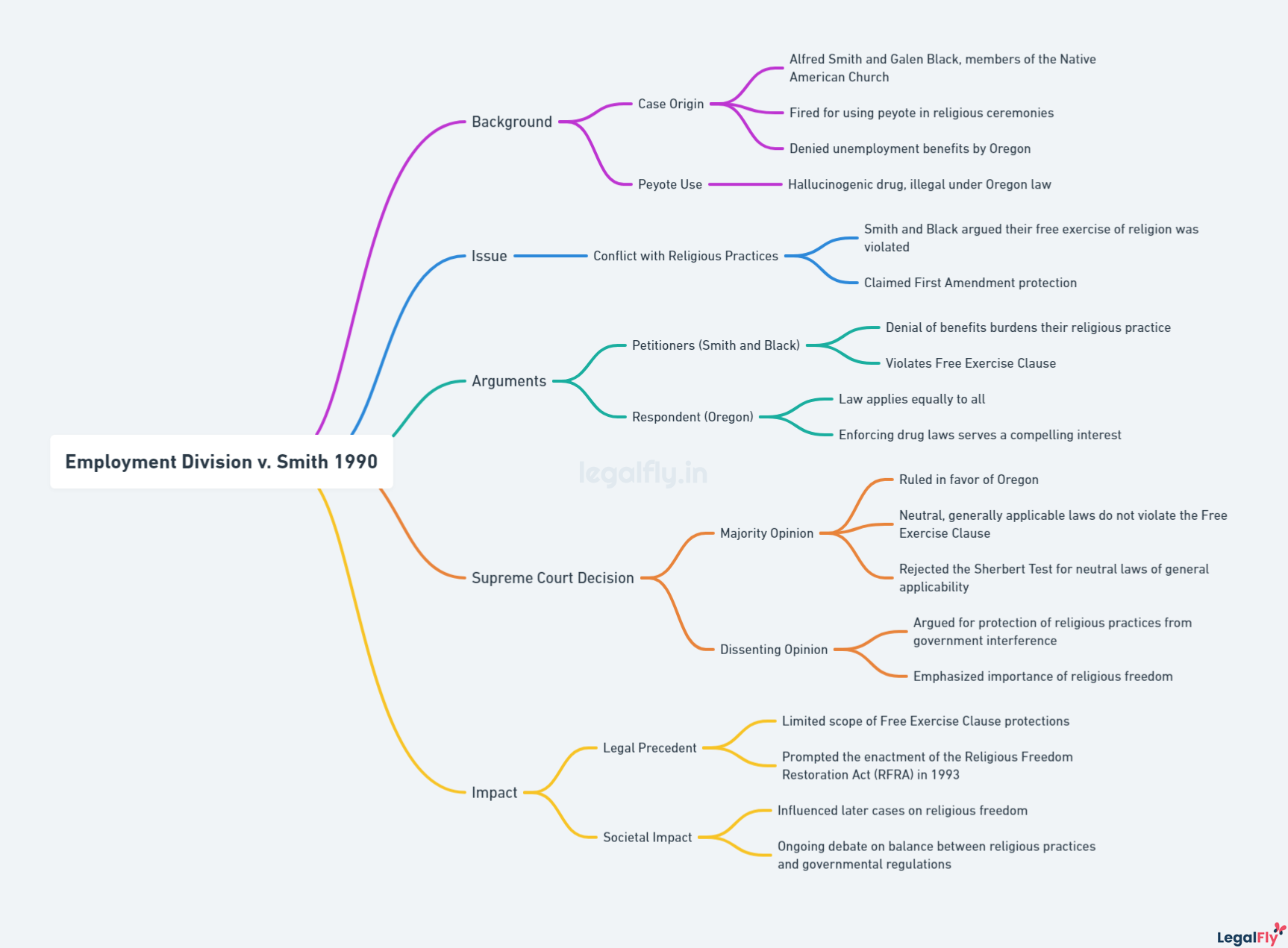
As for blue laws, their prevalence declined across the U.S. through the 20th century as social attitudes changed regarding Sunday closures. By the 2000s, most blue laws were repealed, though some remain on the books restricting Sunday retail activities in certain states. The legacy of Braunfeld is an important, though complex, part of First Amendment jurisprudence.
Conclusion
Braunfeld v. Brown was a landmark 1961 Supreme Court case that examined the boundaries between religious freedom and laws regulating conduct, specifically Pennsylvania’s Sunday closing laws. The Court ruled against the religious freedom claims of Orthodox Jewish business owners who observed Saturday Sabbath and were economically impacted by being forced to close on Sundays as well.
Key Takeaways from Braunfeld v. Brown
- The Court acknowledged the law burdened religious beliefs but ruled that Sunday closing laws had a valid secular purpose.
- Laws that only indirectly burden religious practice, like the Sunday laws, were found to be constitutional.
- The ruling established precedents for evaluating if laws excessively interfere with religious freedom under the First Amendment.
Future of Religious Freedom in Light of Supreme Court Rulings
While Braunfeld was a setback for religious accommodation claims, it did not completely close the door. The Court’s analysis left open the possibility that certain laws or excessive burdens on religion may be unconstitutional. The case paved the way for later decisions that found some burdens on religion were impermissible, like in Sherbert v. Verner. However, courts today still cite Braunfeld when assessing religious freedom challenges to neutral, generally applicable laws. The case’s legacy continues to shape religious liberty jurisprudence in complex ways.

